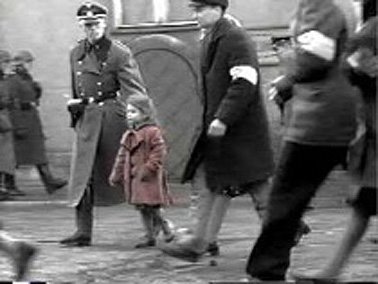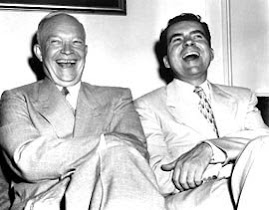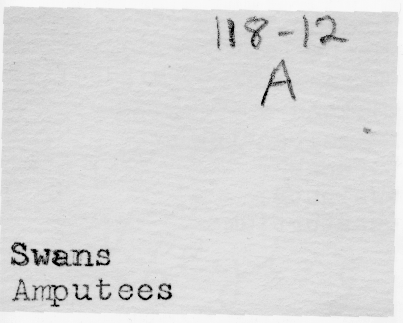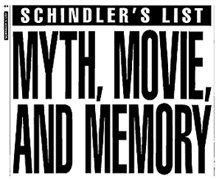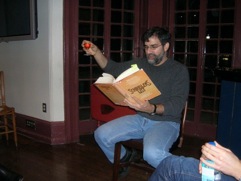 Ange Mlinko reads an "N + 495" poem in celebration of Bernadette Mayer: http://bit.ly/caUpBA. Follow me on twitter.
Ange Mlinko reads an "N + 495" poem in celebration of Bernadette Mayer: http://bit.ly/caUpBA. Follow me on twitter.
Sunday, October 31, 2010
Anthony DeCurtis interviews Keith Richards
 Our own Anthony DeCurtis recently interviewed Keith Richards at the New York Public Library. Here is one of the two courses Anthony will be teaching at CPCW/Writers House in the spring semester.
Our own Anthony DeCurtis recently interviewed Keith Richards at the New York Public Library. Here is one of the two courses Anthony will be teaching at CPCW/Writers House in the spring semester.
Labels:
Anthony DeCurtis,
interview,
Keith Richards,
Rolling Stones
contexts: a poem about a painting
Obviously I've been reading and thinking about Burt Kimmelman's writing recently because Burt was here at the Writers House visiting. Before we move away from this poet, as is inevitable given so much that's going on, let's take one more look. It's a poem with a fabulously open first line: "Nothing is ever decided." Open enough out of context--just as a line--but now add that the poem is about a Robert Motherwell painting (seen at MoMA in January 1988) and, further, that the poet gave an illuminating brief intro to the poem before reading it at KWH the other day. Sometimes I like blogging about these matters because in such a space (as a matter of lasting record) several contexts can be laid out so easily across the various shareable media: the video (above) of the poet's intro; a PDF (click here) of the text of the poem (from the book Musaics, pp. 20-21); the audio-only recording of the poem being performed.
Labels:
Burt Kimmelman,
painting,
Robert Motherwell,
ut pictura poesis
Saturday, October 30, 2010
4 former students read
Install the Flash plugin to watch this video.
Labels:
Kelly Writers House
for teachers of the New York School
 A completely gorgeous performance of his poem "The Circus," by Kenneth Koch. He'd already written a poem called "The Circus" years earlier, and now this is a poem about thinking about having written that poem - a memory of writing that poem, its circumstances, and then some digressing thoughts about circumstances. New York School epitomized.
A completely gorgeous performance of his poem "The Circus," by Kenneth Koch. He'd already written a poem called "The Circus" years earlier, and now this is a poem about thinking about having written that poem - a memory of writing that poem, its circumstances, and then some digressing thoughts about circumstances. New York School epitomized.Many thanks to Curtis Fox, who featured this poem--and this terrific recording--in the most recent episode of the podcast, "Poetry off the Shelf."
Labels:
Kenneth Koch,
New York School,
pedagogy
Friday, October 29, 2010
the snake according to Eileen Myles
 In January 1998, during a reading at the Ear Inn in New York, Eileen Myles read a poem called "Snakes." We recently "found" this poem in that reading; it hadn't been segmented and we just didn't know "Snakes" was one of the poems Myles read that day. I for one am glad of the find. It's quite an interesting poem: story-like but defiant about its story-ness, to say the least. A kind of kunstlerroman, a portrait of this particular artist as a young girl. And not surprisingly it plays with and against the powerful gendered associations of snake. Here is a link to the recording of the poem. And here is the text of the poem as it once appeared in The Massachusetts Review (in 1998).
In January 1998, during a reading at the Ear Inn in New York, Eileen Myles read a poem called "Snakes." We recently "found" this poem in that reading; it hadn't been segmented and we just didn't know "Snakes" was one of the poems Myles read that day. I for one am glad of the find. It's quite an interesting poem: story-like but defiant about its story-ness, to say the least. A kind of kunstlerroman, a portrait of this particular artist as a young girl. And not surprisingly it plays with and against the powerful gendered associations of snake. Here is a link to the recording of the poem. And here is the text of the poem as it once appeared in The Massachusetts Review (in 1998).
Labels:
Eileen Myles,
gender,
PENNsound
telephony so cool it's retro
 About a year ago Curtis Fox, who produces and hosts a weekly poetry podcast for the Poetry Foundation, spoke with me about our dial-a-poem project, which is part of a telephone system we at the Writers House set up, figuring that it was beginning to be, or was well into, an age once again in which telephony was the site of convergence for many if not all things communication. Which is a probably an over-fancy way of saying something obvious about how many of us walk around with smartphones and do email, texting and of course phone-calling on the one portable device. So when our email weekly calendars get sent out, listing and linking to upcoming events at the Writers House for the coming week, at the top of that announcement is our phone number: 215-746-POEM (215-746-7636). When you're looking at this emailed announcement on a smartphone, the device will automatically make a kind of hyperlink of the phone number (it knows to do this for every 10-digit number it sees). Touch that link or scroll to it and hit your button, and the phone will automatically dial it. Because of this, we figured we ought to be there with some cool telephony, retro and cutting-edge both. Try dialing 215-746-7636 right now and see what I mean. Press "3" and you'll hear a single poem recording from PennSound - a poem read at the Writers House. Press "4" and you'll hear a 1-minute performance from a member of the Writers House community. Click here and listen to Curtis Fox's interview with me about this new/old version of "dial-a-poem."
About a year ago Curtis Fox, who produces and hosts a weekly poetry podcast for the Poetry Foundation, spoke with me about our dial-a-poem project, which is part of a telephone system we at the Writers House set up, figuring that it was beginning to be, or was well into, an age once again in which telephony was the site of convergence for many if not all things communication. Which is a probably an over-fancy way of saying something obvious about how many of us walk around with smartphones and do email, texting and of course phone-calling on the one portable device. So when our email weekly calendars get sent out, listing and linking to upcoming events at the Writers House for the coming week, at the top of that announcement is our phone number: 215-746-POEM (215-746-7636). When you're looking at this emailed announcement on a smartphone, the device will automatically make a kind of hyperlink of the phone number (it knows to do this for every 10-digit number it sees). Touch that link or scroll to it and hit your button, and the phone will automatically dial it. Because of this, we figured we ought to be there with some cool telephony, retro and cutting-edge both. Try dialing 215-746-7636 right now and see what I mean. Press "3" and you'll hear a single poem recording from PennSound - a poem read at the Writers House. Press "4" and you'll hear a 1-minute performance from a member of the Writers House community. Click here and listen to Curtis Fox's interview with me about this new/old version of "dial-a-poem."
Labels:
Curtis Fox,
Kelly Writers House,
podcasts,
telephony
Thursday, October 28, 2010
from the other side of these words
Install the Flash plugin to watch this video.

Labels:
Burt Kimmelman,
Creeley,
Kelly Writers House,
WCW
Tuesday, October 26, 2010
Anne Tardos poem for Lytle Shaw
 Anne Tardos created a poem that consists (mostly) of lists of adjectives and adjectival phrases that she'd "picked up" from a reading given by Lytle Shaw in the Segue series. In December 2002 she gave her own reading in The Line Reading Series, where Lytle Shaw introduced her, and so she began with the aforementioned poem, "For Lytle Shaw." Here is the recording. And here is the link to PennSound's Anne Tardos page.
Anne Tardos created a poem that consists (mostly) of lists of adjectives and adjectival phrases that she'd "picked up" from a reading given by Lytle Shaw in the Segue series. In December 2002 she gave her own reading in The Line Reading Series, where Lytle Shaw introduced her, and so she began with the aforementioned poem, "For Lytle Shaw." Here is the recording. And here is the link to PennSound's Anne Tardos page.
Labels:
Anne Tardos,
Lytle Shaw,
PENNsound,
Segue
Monday, October 25, 2010
Ken Irby in 1984

Kenneth Irby reads "Given: Three Beavers in a Tree," a 2 minute, 49 second recording made at Irby's 1984 Ear Inn reading. He also read several poems by Mary Butts and well as his own "Gutter Ode" and several others of his own poems. Thanks to Anna Zalokostas for segmenting this recording for the first time. The whole thing can be found at Ken Irby's PennSound page.
Labels:
Kenneth Irby,
PENNsound
Sunday, October 24, 2010
lists of poetry books, 2010
 For some years Steve Evans at Third Factory has been hosting Attention Span, an annual gathering of readers' lists and commentaries about works of poetry (and related books). I have found these lists suggestive and helpful. Attention Span 2010 is complete now. Here are the first four items on Patrick Durgin's list:
For some years Steve Evans at Third Factory has been hosting Attention Span, an annual gathering of readers' lists and commentaries about works of poetry (and related books). I have found these lists suggestive and helpful. Attention Span 2010 is complete now. Here are the first four items on Patrick Durgin's list:Tan Lin | Seven Controlled Vocabularies and Obituary 2004. The Joy of Cooking [AIRPORT NOVEL MUSICAL POEM PAINTING FILM PHOTO HALLUCINATION LANDSCAPE] | Wesleyan | 2010
I wrote the following blurb for Tan’s metadata event: Tan Lin is the first poetic conceptualist with personality; it is no wonder he has paid scholarly attention to Eliot. But what was tradition has dissipated, as if it so needed, into detritus, and that cultural clog of ingredients are what you find “controlled” in SCV. In my estimation, this is the best book of poetry written yet this century, and precisely because the politics it demands are yet to come, but their context already so familiar.
Christine Wertheim, ed. | Feminaissance | Les Figues | 2010
One of several anthologies that have been useful to me in unexpected ways, the others include The Oxford Book of Latin American Poetry, and…
Brenda Iijima, ed. | eco language reader | Nightboat | 2010
Several things seem to be coming together lately: ecological thinking, somatics, conceptualism (updated, or exploited, depending), feminism, and it’s all here. What’s great about how this collection is comprised and presented is that it posits a center and clarifies the radius of sources past and present for making a foray—you don’t just sit there and absorb, as we say, “the material.” It invites practical pluralities of response. Praise seems beside the point.
Andrew Levy | Cracking Up | Truck | 2010
An old favorite (of a poet) from a new press. The cover shots of Ann-Margaret doing “Bye Bye Birdie” perfectly illustrate the methodically coagulated spurts of late-capitalist wisdom in these pages.
Labels:
Patrick Durgin,
poetry books,
Steve Evans,
Third Factory
the revolution will be typewritten
 Thanks to Darren Wershler-Henry whose recent tweet turned me on to The Boston Typewriter Orchestra. They are "a collective endeavor which engages in rhythmic typewriter manipulation combined with elements of performance, comedy and satire. BTO aims to entertain the masses while providing an outlet for the creative urges of its members. *BTO promises to protect customer confidentiality with the utmost vigilance while remaining irreverent at all times." Listen here and enjoy a new single, "The Revolution Will Be Typewritten."
Thanks to Darren Wershler-Henry whose recent tweet turned me on to The Boston Typewriter Orchestra. They are "a collective endeavor which engages in rhythmic typewriter manipulation combined with elements of performance, comedy and satire. BTO aims to entertain the masses while providing an outlet for the creative urges of its members. *BTO promises to protect customer confidentiality with the utmost vigilance while remaining irreverent at all times." Listen here and enjoy a new single, "The Revolution Will Be Typewritten."
Labels:
typewriter
Friday, October 22, 2010
Burt Kimmelman here on Tuesday
 To readers of my blog in the Philly area: I hope you will join us on Tuesday at 6 PM to meet and hear the work of Burt Kimmelman. See the announcement below.
To readers of my blog in the Philly area: I hope you will join us on Tuesday at 6 PM to meet and hear the work of Burt Kimmelman. See the announcement below.- - -
Poet BURT KIMMELMAN will be reading at the Kelly Writers House next Tuesday, October 26, at 6:00 PM. A professor of English at NJIT, he has been called “a successor to the lineage of William Carlos Williams and George Oppen” by Jerome Rothenberg, as well a projector of “great possibility” in his latest collection, As If Free. Please help us welcome Mr. KIMMELMAN, who’ll be introduced by our own Al Filreis!
The Kelly Writers House presents
BURT KIMMELMAN
Tuesday, October 26, at 6:00 PM in the Arts Café
Kelly Writers House | 3805 Locust Walk
No registration required - this event is free & open to the public
BURT KIMMELMAN has published six collections of poetry – As If Free (Talisman House, Publishers, 2009), There Are Words (Dos Madres Press, 2007), Somehow (Marsh Hawk Press, 2005), The Pond at Cape May Point (Marsh Hawk Press, 2002), a collaboration with the painter Fred Caruso, First Life (Jensen/Daniels Publishing, 2000), and Poetry New York: A Journal of Poetry and Translation. He is a professor of English at New Jersey Institute of Technology and the author of two book-length literary studies: The "Winter Mind": William Bronk and American Letters (Fairleigh Dickinson University Press, 1998); and, The Poetics of Authorship in the Later Middle Ages: The Emergence of the Modern Literary Persona (Peter Lang Publishing, 1996; paperback 1999). He also edited The Facts on File Companion to 20th-Century American Poetry (Facts on File, 2005) and co- edited The Facts on File Companion to American Poetry (Facts on File, 2007). He has published scores of essays on medieval, modern, and contemporary poetry.
Labels:
Burt Kimmelman,
Kelly Writers House,
WCW
he's no alien
 Nope, he's about as terrestrial a person and poet as there is. This is a new and better version of a photograph taken by Lawrence Schwartzwald, and I'm happy to feature it today.
Nope, he's about as terrestrial a person and poet as there is. This is a new and better version of a photograph taken by Lawrence Schwartzwald, and I'm happy to feature it today.
Labels:
Charles Bernstein,
Lawrence Schwartzwald
Thursday, October 21, 2010
poetry & pumpkin chili, coming right up

Listen to an announcement about an upcoming event featuring Cristin O'Keefe Aptowicz, who is our 2010-11 ArtsEdge artist in residence. By the way, she's providing Pumpkin Chili that night, based on a secret family recipe.
Labels:
Kelly Writers House,
spoken-word poetry
Tuesday, October 19, 2010
Writers House 15th featured
 The University of Pennsylvania home page today (and presumably for a few days) features the Kelly Writers House - helping us mark our fifteenth year. (October 1995 to October 2010.) Now go here and watch a fabulous slide show: some wonderful photos of Writers House people in action. Here's the text:
The University of Pennsylvania home page today (and presumably for a few days) features the Kelly Writers House - helping us mark our fifteenth year. (October 1995 to October 2010.) Now go here and watch a fabulous slide show: some wonderful photos of Writers House people in action. Here's the text:- - -
Spotlight: Kelly Writers House Celebrates 15 Years of Success
Fifteen years ago a band of forward-thinkers believed there should be a place on campus where people could gather to appreciate, create, study and participate in every aspect of the writing process. The place, they believed, should exist outside the conventional classroom, be open to everyone in the community and be run by those who would use it.
That vision became the Kelly Writers House (KWH) at 3805 Locust Walk, which is celebrating its 15th anniversary on Oct. 30.
Al Filreis, the Kelly professor of English and one of the house's original founders recalls that KWH was established in 1995 on the idea that students at Penn deserved a place on campus where they could find a rich intellectual experience that had nothing to do with the curriculum.
Today, the house stands as a shining example of the power of artistic and educational collaboration put into practice. It's a place where novelists, poets, journalists, screenplay writers, humorists, food writers and others meet, work, dine and mingle.
In the early days, the house was known simply as the Writers House. But about a year into the Writers House initiative, Penn alumnus and Chairman of the China Ceramics Company Paul K. Kelly dropped by to see what was going on in the shabby Tudor-style cottage on Locust Walk.
 “He met with me and the house's first director, and it just happened that on that day there was a jazz band playing in the front room and cookies and cakes were baking in the kitchen,” Filreis says. “He absolutely loved the place, and within 20 minutes he pledged $1 million to help fix it up.” Kelly's gift allowed for a complete renovation of the site that included new plumbing, restoration of the fireplaces, an updated kitchen and the painting of the exterior of the house with its original colors of tan and Fairmount green. Its new name was the Kelly Writers House.
“He met with me and the house's first director, and it just happened that on that day there was a jazz band playing in the front room and cookies and cakes were baking in the kitchen,” Filreis says. “He absolutely loved the place, and within 20 minutes he pledged $1 million to help fix it up.” Kelly's gift allowed for a complete renovation of the site that included new plumbing, restoration of the fireplaces, an updated kitchen and the painting of the exterior of the house with its original colors of tan and Fairmount green. Its new name was the Kelly Writers House.Over the past 15 years, Kelly Writers House has welcomed world-class authors such as Joan Didion, Richard Ford, Ian Frazier, Joyce Carol Oates, Jamaica Kincaid, Grace Paley, Gay Talese, John Edgar Wideman and others. This year, Marjorie Perloff, Susan Cheever and Edward Albee will work with students through the Kelly Writers House Fellows program.
“It's more than just a venue for readings and events,” says Lily Applebaum, a junior in The College. “There is a real emphasis on community-building here, anybody can come in and make the space their own.”
Text by Tanya Barrientos
Photos courtesy of the Kelly Writers House & Steven Minicola
Labels:
Kelly Writers House,
Penn
it makes of nonsense
 Speaking of Ray DiPalma. We've segmented another reading by him; this one took place on November 10, 1977, and he read with Michael Lally and Bruce Andrews. He read four pieces. One of them, very short, begins "It makes of nonsense..." I think it's quite compelling. Listen yourself and decide.
Speaking of Ray DiPalma. We've segmented another reading by him; this one took place on November 10, 1977, and he read with Michael Lally and Bruce Andrews. He read four pieces. One of them, very short, begins "It makes of nonsense..." I think it's quite compelling. Listen yourself and decide.
Labels:
nonsense,
PENNsound,
Ray DiPalma
listen to the biography of Elsa von Freytag Loringhoven, the "Baroness"

Here is an audio version of the biographical profile of the Baroness that was published in the sixth issue of Sulphur (1983), read by Shawn Walker: MP3.
Labels:
audio,
the Baroness
Sunday, October 17, 2010
oh, the things art students will do
Animal Cruelty, or Art?
GAINESVILLE, Fla., April 5 [1996] (Associated Press)
A college senior who dipped 40 live baby mice into resin, then cut the material into cubes for an art project, was charged with animal cruelty today.
The student, Vincent Gothard, a 25-year-old fine arts major at the University of Florida, faces up to five years in prison and a $10,000 fine if convicted.
Mr. Gothard's lawyer, Robe Rush, defended the art project, saying the mice died instantly and were destined to become food for other animals anyway. He also maintained that the project was " clearly artistic expression and probably protected by the First Amendment."
GAINESVILLE, Fla., April 5 [1996] (Associated Press)
A college senior who dipped 40 live baby mice into resin, then cut the material into cubes for an art project, was charged with animal cruelty today.
The student, Vincent Gothard, a 25-year-old fine arts major at the University of Florida, faces up to five years in prison and a $10,000 fine if convicted.
Mr. Gothard's lawyer, Robe Rush, defended the art project, saying the mice died instantly and were destined to become food for other animals anyway. He also maintained that the project was " clearly artistic expression and probably protected by the First Amendment."
Labels:
contemporary art,
legal implications of art,
news
Thursday, October 14, 2010
the way Gertrude Stein wrote book reviews

Compare two reviews of Alfred Kreymborg's chatty group-bio/memoir of the high-flying modernists of Europe and New York in the late 1910s and early '20s. One is Gertrude Stein's book review published in Ex Libris, a magazine put out in Paris. The other, written by Mark Van Doren, was published in the Nation. At right is an image of the Stein review as it appeared in the magazine; click on the image for a larger view.
Labels:
book reviews,
books,
Gertrude Stein,
Mark Van Doren,
reviewing
Wednesday, October 13, 2010
Monday, October 11, 2010
PennSound on YouTube
 In this video clip, watch and hear Juliana Spahr read from her work, "The Incinerator." The clip is 8 minutes long and was prepared for our PennSound YouTube channel: http://www.youtube.com/user/pennsound. There are now 118 videos uploaded to PennSound on YouTube. They range from David Antin rethinking Freud to Kaegan Sparks introducing Christian Bok to John Yau talking with Charles Bernstein.
In this video clip, watch and hear Juliana Spahr read from her work, "The Incinerator." The clip is 8 minutes long and was prepared for our PennSound YouTube channel: http://www.youtube.com/user/pennsound. There are now 118 videos uploaded to PennSound on YouTube. They range from David Antin rethinking Freud to Kaegan Sparks introducing Christian Bok to John Yau talking with Charles Bernstein.
Labels:
Charles Bernstein,
John Yau,
Juliana Spahr,
PENNsound,
video,
YouTube
Sunday, October 10, 2010
British blew up humanitarian flotillas after the Holocaust
"A new book to be published next week entitled MI6: The History of the Secret Intelligence Service 1909-1949, by Keith Jeffery, reveals the existence of Operation Embarrass, a plan to try to prevent Jews getting into Palestine in 1946-'48 using disinformation and propaganda but also explosive devices placed on ships. Nor is this some speculative spy story that can be denied by the authorities: Jeffrey's book is actually, in their own words: 'Published with the permission of The Secret Intelligence Service and the Controller of Her Majesty's Stationery Office.'" Here is a link to the full review/article by Andrew Roberts.
Labels:
Great Britain,
holocaust
Friday, October 08, 2010
PoemTalk's 36th episode now out
 The latest episode of PoemTalk is being released just now - the 36th show in our series. Go here for program notes and a link to the audio.
The latest episode of PoemTalk is being released just now - the 36th show in our series. Go here for program notes and a link to the audio.
modernist pedagogy at the end of the lecture
 This essay on modernist poetry at the end of the lecture is now available through the Selected Works site. Many thanks to Peter Middleton and Nicky Marsh for commissioning it and for fabulous editorial and other advice along the way. Thanks also to Julia Bloch, whose class session on the sounds of Amiri Baraka was inspirational. Also to Ira Winston, John MacDermott, the late Jack Abercrombie, Chris Mustazza and Mark Lindsay who have pushed me toward using digital media and computing in my teaching and who on occasion permitted me to push them. RIP, Jack!
This essay on modernist poetry at the end of the lecture is now available through the Selected Works site. Many thanks to Peter Middleton and Nicky Marsh for commissioning it and for fabulous editorial and other advice along the way. Thanks also to Julia Bloch, whose class session on the sounds of Amiri Baraka was inspirational. Also to Ira Winston, John MacDermott, the late Jack Abercrombie, Chris Mustazza and Mark Lindsay who have pushed me toward using digital media and computing in my teaching and who on occasion permitted me to push them. RIP, Jack!
Labels:
higher education,
modernism,
pedagogy
Wednesday, October 06, 2010
recruiting young writers
 Penn's student newspaper, The Daily Pennsylvanian, ran a story in this morning's paper about our efforts at the Writers House to find talented writers among high-school student candidates for admission to the university.
Penn's student newspaper, The Daily Pennsylvanian, ran a story in this morning's paper about our efforts at the Writers House to find talented writers among high-school student candidates for admission to the university.
Labels:
higher education,
Kelly Writers House,
Penn
selections from the audio archives
 The folks over at Brain Pickings have selected some gems from the audio archives of the Kelly Writers House. Have a look and listen.
The folks over at Brain Pickings have selected some gems from the audio archives of the Kelly Writers House. Have a look and listen.
Labels:
audio,
Kelly Writers House
radical artifice and other topics, 1991
We at PennSound have just segmented an interview with Marjorie Perloff conducted by Aldon Nielsen for the Incognito Lounge in Palo Alto, CA, November 12, 1991. Here are the clips:
introduction by A.L. Nielsen (0:51): MP3
work on Frank O'Hara (7:13): MP3
"The Futurist Moment, poetic movements, and marginalized works (7:47): MP3
"The Poetics of Indeterminacy" and John Cage (15:02): MP3
the avant-garde and post-modernism (7:57): MP3
"The Radical Artifice," poetic language, and authentic speech (13:16): MP3
L=A=N=G=U=A=G=E poets (7:42): MP3
Wittenstein and Gertrude Stein (6:52): MP3
And the complete interview (1:06:36): MP3. Here is the link to PennSound's Perloff page.
And the complete interview (1:06:36): MP3. Here is the link to PennSound's Perloff page.
Labels:
Aldon Nielsen,
Marjorie Perloff,
PENNsound
Monday, October 04, 2010
Sunday, October 03, 2010
poetry and anticommunism, an essay-length primer
 I've now made my essay "Modern Poetry and Anticommunism" available through Selected Works. Citation: Alan Filreis. "Modern Poetry and Anticommunism." A Concise Companion to Twentieth-Century American Poetry. Ed. Stephen Fredman. Oxford, UK: Blackwell, 2005. 173-190.
I've now made my essay "Modern Poetry and Anticommunism" available through Selected Works. Citation: Alan Filreis. "Modern Poetry and Anticommunism." A Concise Companion to Twentieth-Century American Poetry. Ed. Stephen Fredman. Oxford, UK: Blackwell, 2005. 173-190.
Labels:
anticommunism,
communism
neo-Nazi teaches high-school history
Install the Flash plugin to watch this video.
Friday, October 01, 2010
we want water in every originist myth
Ah, the way we humans find ways to mythologize water. It flows into almost every narrative we make about origins. Here's my favorite instance of this:
I hardly need to say that the Mets were originally conceived as a balm to the wounds felt by Giant and Dodgers fans whose National League teams were stolen from them (moving to California) in the late 50s, in moves that have often and can really only be interpreted as white flight.
By the way, my friend Peter Tarr, who passed along this factoid to me, himself attended that first Shea game, April 18, 1964, the first of many, many losses Pete has endured.
On April 16, 1964, the day before Shea Stadium officially opened, Bill Shea christened the Mets' new home with two symbolic bottles of water: one from the Gowanus Canal, near Ebbets Field, the former home of the Brooklyn Dodgers and one from the Harlem River, near the Polo Grounds, where the New York Giants had played and later the Mets during their first two years. The next morning, April 17th, construction workers were painting outfield signs and fresh sod was being laid in the outfield as the teams took batting practice. (The Mets lost, 4-3, to Pittsburgh that afternoon.)
I hardly need to say that the Mets were originally conceived as a balm to the wounds felt by Giant and Dodgers fans whose National League teams were stolen from them (moving to California) in the late 50s, in moves that have often and can really only be interpreted as white flight.
By the way, my friend Peter Tarr, who passed along this factoid to me, himself attended that first Shea game, April 18, 1964, the first of many, many losses Pete has endured.
Subscribe to:
Posts (Atom)









 "I teach horizontally, meaning that while I might begin with a fixed idea of what I'm going to teach that day, I let it drift rhizomatically way off topic, often pulling it back when it gets too far. I rely on non-fixed materials to teach this way; the whole world is at my fingertips. Should I go off on a tangent about John and Rauschenberg and their love relationship as expressed in Rauschenberg's bed, an image of that bed is always a click away. From there, we can head anywhere into the non-fixed universe, be it film, text or sound. And of course, that always takes us elsewhere. As Cage says, 'We are getting nowhere fast.'"
"I teach horizontally, meaning that while I might begin with a fixed idea of what I'm going to teach that day, I let it drift rhizomatically way off topic, often pulling it back when it gets too far. I rely on non-fixed materials to teach this way; the whole world is at my fingertips. Should I go off on a tangent about John and Rauschenberg and their love relationship as expressed in Rauschenberg's bed, an image of that bed is always a click away. From there, we can head anywhere into the non-fixed universe, be it film, text or sound. And of course, that always takes us elsewhere. As Cage says, 'We are getting nowhere fast.'" 

 that anyone has yet got the imaginative measure of that terrifying day six years ago. Certainly our Tolstoy has not crawled out of the rubble. The closest we have, Don DeLillo, succeeded as an essayist-journalist ("In the Ruins of the Future: Reflections on Terror and Loss in the Shadow of September,” Harper’s, December 2001) but, to my mind, failed as a novelist ("Falling Man"). One reason, perhaps, is that the remembered emotion was instantly buried under a pile of cultural junk.' - Tod Gitlin in his review of Susan Faludi's The Terror Dream (written for
that anyone has yet got the imaginative measure of that terrifying day six years ago. Certainly our Tolstoy has not crawled out of the rubble. The closest we have, Don DeLillo, succeeded as an essayist-journalist ("In the Ruins of the Future: Reflections on Terror and Loss in the Shadow of September,” Harper’s, December 2001) but, to my mind, failed as a novelist ("Falling Man"). One reason, perhaps, is that the remembered emotion was instantly buried under a pile of cultural junk.' - Tod Gitlin in his review of Susan Faludi's The Terror Dream (written for 


